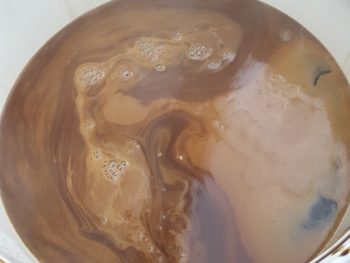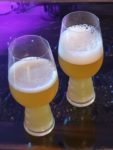
Okay, so my plan is to document all my brew days. This is my first attempt, for an Oatmeal Stout…
When you’re brewing frequently, you’ve kind of got to take notes.
Otherwise how are you going to learn from your mistakes?
Anyway, until now, I’ve kept my notes on scraps of paper, which I’ve tried to remember to upload onto Evernote, my favourite productivity app.
Which is handy for me, but I thought it would be useful for my readers if I was to share my results. It might also be handier for me, too.
Sometimes, I expect to have to share some mistakes and disappointments. Which you’ll be able to learn from, or, if you’re a more experienced brewer than I, you’ll be able to laugh at my foolishness.
I also hope to share some successes, too.
This preamble being said, this is my brew day, 15th June 2020, brewing a batch of 22L of coffee-infused Oatmeal Stout. I used the BIAB method, simply because that’s the gear I have.
I botched together the recipe from a few different recipes I found on the internet, having never tried making this style before.
So, first the ingredients:

I started with a base malt of 3.3 kg Weyermann Pilsner Malt…
And added to that: 360g of Crisp Brown Malt; 360g Low Colour Chocolate Malt; 360g of Weyermann Roasted Barley; 180g of Chocolate Malt; 360g of Weyermann CaraAmber.
For the oatmeal, I added 1.65 kg of Crisp Flaked Torrified Oats.
That’s a total grain bill of 6.570 kg
For hops, I used 95 g Centennial hop pellets, and 75 g Cascade hop pellets. I split these between two hop bags.
I chose a Lallemand BRY-97 Pale Ale Dried Yeast.
I started off with 26 liters of water, and heated up to 69°c, because my target mashing temperature was 67°c, and I expected the addition of grains to drop the temperature by a couple of degrees.
I added my grain bill, and let mashing take place for 1 hour.
Every 20 minutes, I went back and checked that the temperature was still good. Happily, it was a warm day, so it only lost 1°c over the entire hour.
I removed the grain bag, and sat it in the makeshift colander that I made for my mashing bucket, leaving it to drain.
Although BIAB is supposed to be a no-sparge method, I poured a few kettle-fulls of water through the grain to maximise the wort efficiency, and then gave the grain bag a good squeeze with my strangely-asbestos hands.
I then had 25 litres of wort, which I brought to the boil, and added my first hop bag for a boil time of 60 minutes.

My second hop addition was for the last 20 minutes, and in the last 10 minutes I added a Whirlfloc tablet.
I didn’t chill my wort as you are supposed to, and just left it to cool down overnight. I must confess that I usually do this, and haven’t found it to cause any problems so far.
16th June – Fermentation started
I transferred my wort into a sanitised fermentation bucket, and at this point had 19 Litres of wort, with a gravity of 1.060. (I had to sacrifice a fair bit of wort, due to trub.)
I added some water, and about 500 g of medium dried malt extract, to get 22 litres of wort with an OG of 1.062
Re-hydrated yeast was added, with a starting temperature of the wort at 23°c.
Fermentation started fast-ish, with bubbling airlock activity after around 6 hours.
Adding Coffee
I added this after fermentation had slowed down, after five days.
I’ve never added coffee to homebrew before, and I was concerned about adding too much bitterness. I read up on coffee additions and came to the conclusion that this time I would brew about 350 g of medium ground coffee overnight in a pint of cold water. I strained the coffee and added it to the fermentor on the 21st.
The coffee did have a certain ashtray-smell, so I was glad I didn’t make too much. I can always add more next time…
Bottling (28th June)
I was busy, and bottled a couple of days later than I planned.
The final gravity stood at 1.020, giving me an approximate 5.5% ABV. I know that the temperature had been roughly the same at both start and end of fermentation, so I haven’t made any adjustments for temperature.
I tasted the oatmeal stout at this point, obviously warm and flat. I’ve got the feeling it should be pretty acceptable, with a good level of body, a nice mouthfeel, and a reasonable level of hop bitterness. The coffee addition was understated but discernable.
Bottled yield was 20 litres.
I will update on the 4th of July with my first impressions after secondary fermentation, and then I will leave it to mature a bit in the fridge for a couple more weeks. Unless I’m really thirsty…
First Tasting after Bottle Conditioning
My first impression of this beer was that it was a little too bitter, and I couldn’t really taste the coffee.
After a few more days in the fridge, (ten days after bottling, of which, five days priming, and five in the fridge) I was pleasantly surprised how much it had improved. The bitterness had mellowed, and the coffee, while understated, was discernible.
Tasting Notes
It’s definitely a richer beer than a Dry Irish stout.
There’s a lot of grain in this, and the oats do lend a more creamy mouthfeel.
There are certainly some dark-chocolate notes, and a little espresso.
I’m wondering if I read my hydrometer properly, as there is a slightly more alcoholic-warmth than I would expect from my calculated 5.5%
Anyway, this beer goes down very nicely indeed. I don’t think it needs any further aging – the flavour is unlikely to improve significantly from a longer period in the fridge.
If you fancy giving it a go, check out my All Grain Oatmeal Stout recipe…






 Brew Day Checklist
Brew Day Checklist





